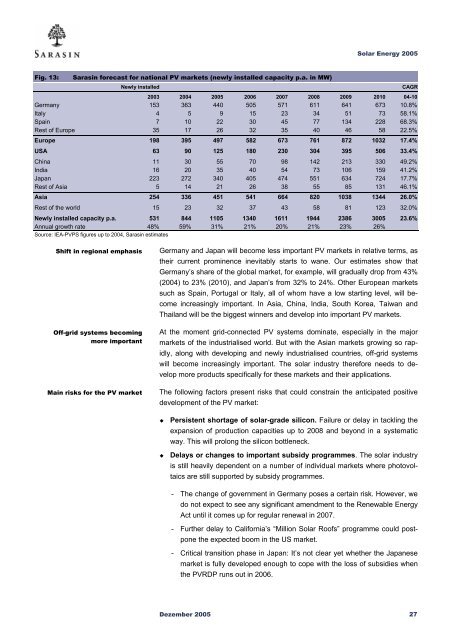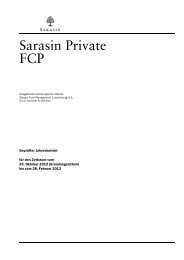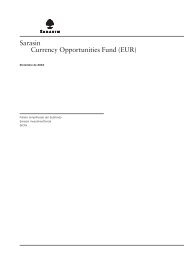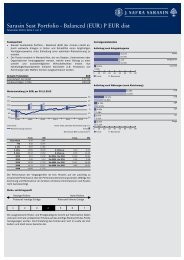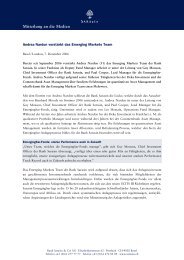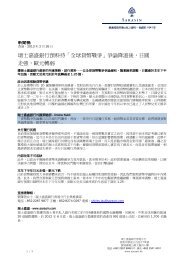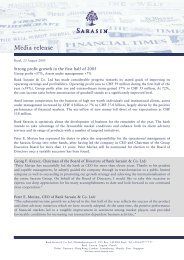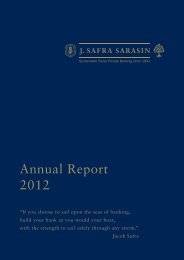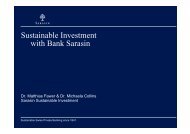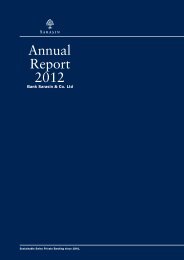Sustainability Report - Bank Sarasin-Alpen
Sustainability Report - Bank Sarasin-Alpen
Sustainability Report - Bank Sarasin-Alpen
Create successful ePaper yourself
Turn your PDF publications into a flip-book with our unique Google optimized e-Paper software.
Solar Energy 2005<br />
Fig. 13:<br />
<strong>Sarasin</strong> forecast for national PV markets (newly installed capacity p.a. in MW)<br />
Newly installed<br />
2003 2004 2005 2006 2007 2008 2009 2010 04-10<br />
Germany 153 363 440 505 571 611 641 673 10.8%<br />
Italy 4 5 9 15 23 34 51 73 58.1%<br />
Spain 7 10 22 30 45 77 134 228 68.3%<br />
Rest of Europe 35 17 26 32 35 40 46 58 22.5%<br />
Europe 198 395 497 582 673 761 872 1032 17.4%<br />
USA 63 90 125 180 230 304 395 506 33.4%<br />
China 11 30 55 70 98 142 213 330 49.2%<br />
India 16 20 35 40 54 73 106 159 41.2%<br />
Japan 223 272 340 405 474 551 634 724 17.7%<br />
Rest of Asia 5 14 21 26 38 55 85 131 46.1%<br />
Asia 254 336 451 541 664 820 1038 1344 26.0%<br />
Rest of the world 15 23 32 37 43 58 81 123 32.0%<br />
Newly installed capacity p.a. 531 844 1105 1340 1611 1944 2386 3005 23.6%<br />
Annual growth rate 48% 59% 31% 21% 20% 21% 23% 26%<br />
Source: IEA-PVPS figures up to 2004, <strong>Sarasin</strong> estimates<br />
CAGR<br />
Shift in regional emphasis<br />
Off-grid systems becoming<br />
more important<br />
Main risks for the PV market<br />
Germany and Japan will become less important PV markets in relative terms, as<br />
their current prominence inevitably starts to wane. Our estimates show that<br />
Germany’s share of the global market, for example, will gradually drop from 43%<br />
(2004) to 23% (2010), and Japan’s from 32% to 24%. Other European markets<br />
such as Spain, Portugal or Italy, all of whom have a low starting level, will become<br />
increasingly important. In Asia, China, India, South Korea, Taiwan and<br />
Thailand will be the biggest winners and develop into important PV markets.<br />
At the moment grid-connected PV systems dominate, especially in the major<br />
markets of the industrialised world. But with the Asian markets growing so rapidly,<br />
along with developing and newly industrialised countries, off-grid systems<br />
will become increasingly important. The solar industry therefore needs to develop<br />
more products specifically for these markets and their applications.<br />
The following factors present risks that could constrain the anticipated positive<br />
development of the PV market:<br />
<br />
<br />
Persistent shortage of solar-grade silicon. Failure or delay in tackling the<br />
expansion of production capacities up to 2008 and beyond in a systematic<br />
way. This will prolong the silicon bottleneck.<br />
Delays or changes to important subsidy programmes. The solar industry<br />
is still heavily dependent on a number of individual markets where photovoltaics<br />
are still supported by subsidy programmes.<br />
- The change of government in Germany poses a certain risk. However, we<br />
do not expect to see any significant amendment to the Renewable Energy<br />
Act until it comes up for regular renewal in 2007.<br />
- Further delay to California’s “Million Solar Roofs” programme could postpone<br />
the expected boom in the US market.<br />
- Critical transition phase in Japan: It’s not clear yet whether the Japanese<br />
market is fully developed enough to cope with the loss of subsidies when<br />
the PVRDP runs out in 2006.<br />
Dezember 2005 27


